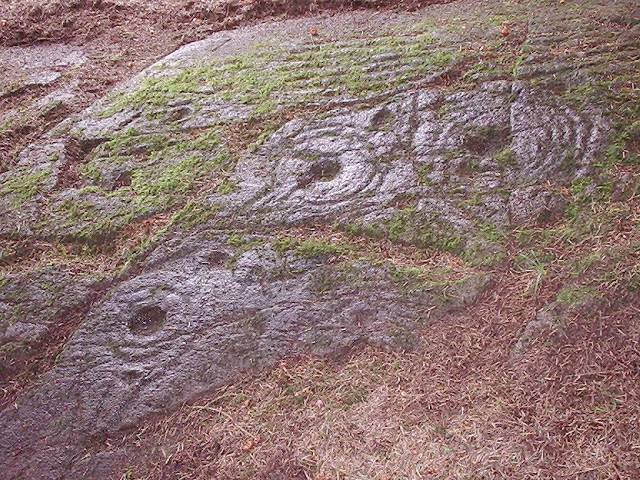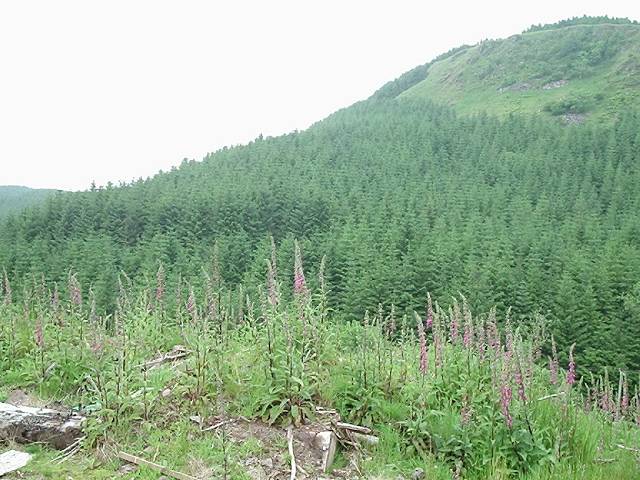





















View of the rock art in its context – if you follow the line of spruce trees from the right of the photo to where they end, the rock art is in a grassy patch below the last trees, between two patches of clear-felling.


With sea in the background for context – sorry for the wonkiness of this picture!


You can see that the black stuff mentioned in rockartuk’s post has increased – I reckon it’s some kind of lichen.

The Ormaig rock art site in May 2011 (centre of pic). The trees have gone!

Zoom from the forest track from the other side of the valley on approach showing tree stumps and roots running through the rock art panels

The view over the area of clearance which revealed the new carvings, but was also to aid the Half Life Project.
nva.org.uk/new-projects/half+life/
We were lucky enough to be given access for a special advance preview on saturday the 1st september. The whole experience is one that has to be seen, a must see.

The view down the long panel under tree cover, dark, needing a little help from the flash.

more of the new carvings.



some of the new carvings, which do seem to link to the cracks and fissures in the rock surfaces. ( One for Rich i think!)


The main panel with the “rosettes”. Note the black area near the rosettes.

Panel with cups, some with one ring, in the wood

The most Northerly carvings on site 2, a steeply slooping finger of bare rock

Unusual motif halfway site 2; the outer -third- ring runs down with a groove.

A nice panel of rock art in the middle of site 2. The seven -not as short as mentioned in the inventory- parallel grooves, grown over by fresh moss, are clearly visible. These parallel grooves are a most unusual feature for Scottish rock art.


Site 2, the slooping finger of bare rock, seen from the N. The decorated panel is about 6 m long and fractured.

Site 2, the beginning of another rosette. The fresh moss was intentionally not cleared away because this may damage the motif.

View to the site from the road. The location can be seen just over the top of the highest foxglove. It is clear that the main panels are on a terrace which is not planted with trees.

Main rosette on rock (1).

The rosette area of rock (1).

Rosette and other carvings on rock (1) – W of the main group of rosettes.

The S part of rock (1).

The N part of rock (1).

One of the sites in the forest.
Probably part of rock (3).


Unearthing hidden treasures at Ormaig
“An open day was held at the Ormaig rock art site looking over Loch Craignish on Saturday to display the work of the recent excavation project. The project is a joint effort with the Forestry Commission and Kilmartin House Museum with Dr Andy Jones from the Archaology department at the University of Southampton casting his expert eye on proceedings.
The Forestry Commission are felling the trees around the site next year so the project is trying to discover the extent of the site to ensure it is preserved properly in the future and not damaged in the process of felling.
The excavation so far has found some hammer stones which might have been used for making tools rather than as tools themselves. It has also uncovered some more cup and ring marks typical of the area.
Dr Jones said:’We have found a lot of new motifs and hammer stones inserted into cracks and fissures on the rocks. There’s a good chance we’ll find more. Whenever we work on a project with rock art we usually find something else.’ ”
Argyllshire Advertiser, 20 July 2007
Visited Thursday 25/5/17 – the sun finally broke through the mist/drizzle of earlier in the week and it was actually hot. Started walk from the car park for Carnassarie Castle following the directions from ‘Walk 3’ in “In The Footsteps Of Kings” book (purchased earlier in the week from Kilmartin Museum shop) which also contains a clear map and grid references. Distance 7km/4.4 miles.
Quite a strenuous walk through pine woodland but mostly in the open so not much respite from the strange phenomena of strong sunshine. Much of what was forest has now been felled. Still a lovely walk though, with a cuckoo clearly calling throughout. The panels can be seen on the hillside as you approach downhill and the walk back up to them was particularly lovely with a fast flowing stream below, butterflies and moths scattering before us onto the late bluebells and other wild flowers.
The views from the panels towards Loch Craignish were stunning in the sunlight. The interpretation board at the bottom of the slope suggested that perhaps the carvings were made to indicate the way from the sea to Kilmartin Glen burial centre.
There are seven discrete panels exposed, one with the quite rare rosette design, rings, parallel lines and grooves. On one of the smaller stones just cup marks. Now protected as an Ancient Scheduled Monument, one of the lower panels has names carved by John Campbell in 1874 and Archie Campbell in 1877.
The walk back was very interesting as we took time to walk up to the two standing stones and cairn just above Carnasserie Castle, which was a wonderful spot. Perhaps it was the lovely weather or the slightly challenging walk – this visit remains very vivid in my memory.
We visited the site on the 8th of June, a couple of weeks before Greywether. What struck us first of all was the state the motifs were in. So much more weathered than a couple of years ago. Furthermore there was a black area near the rosettes -also seen on Greywether´s pics- which consits of dead mosses. The substance felt like tarmac and it seems as if the mosses were burned or manipulated with some sort of -acid?- liquid. There could be a natural reason for this weird phenomenon as well. But in that case it is strange that it is seen in only a small, limited area.
We brushed some pine-needles away at site 2 to clear the long N-S panel in the wood. On former visits we weren´t able to make much of it because of the thick moss-layer which we left in place then. But now we were more lucky and photographed the splendid motifs. Had we known that Greywether was following our trail we would have left the needles of. Sorry, mate!
Making a return visit to this site was the main reason for scheduling a further visit to Kilmartin as an add-on to the Achnagoul sites. These things are largely determined by the weather and, as it turned out, this resulted in my coming back less than a week since my previous visit.
It is, of course, the rosettes which are the main attraction here and wonderful they are to – deeply carved and visible in any lighting conditions. The main rosette on rock (1) – see Miscellaneous below for numbering – is 30cm wide.
I met Arran and Emma from hengeweb.com at the site and we looked for the other rocks in the forest. We could find only one which we thought was part of rock (2). However, having studied the plan of (2) in more detail, I’m not so sure – it could be part of (3) that we found.
As regards access, I’ve not tried the method described in the link below. I parked at the Carnassarie Castle car park and walked from there. This takes you past the Carnassarie stones to enter the forest at NM834010 on a track which meets up with the forest road described in the link – a short distance before the ruined house.
Visited 25 June 2004
There are six areas of decoration here as listed in the Royal Commission Inventory and the Kilmartin extract.
The two areas which you see when you arrive at the site (with the rosetttes and the graffiti) are, in the Inventory, one site – number (1).
Number (2) is described as “a steeply sloping finger of bare rock a short distance N of (1)“. It is about 6m long running N to S. Heavily decorated including a further rosette.
Number (3) is “immediately W of the top of (2)” – two groups of cups and single rings.
Number (4) is 2m NNW of (3). Six plain cups.
Number (5) is 1m N of (4). Nine cups and five cups with single rings.
Number (6) is 4m N of (2). Ten cups.
(2) to (6) are in the forest, covered in pine needles and may be difficult to find.
Ormaig on BRAC
Ormaig Prehistoric Rock Art.
Images and description for this hidden site – gives directions, which is nice!






























































































































